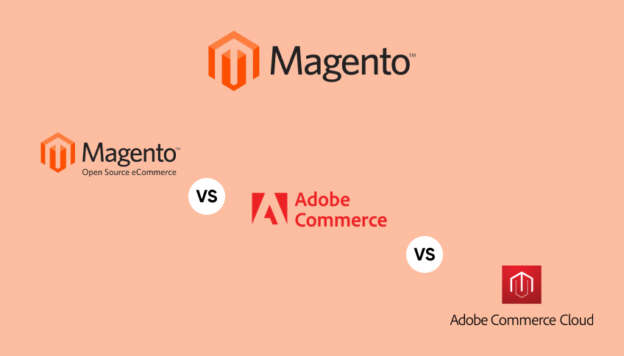Being a part of eCommerce development services, Adobe commerce agency services can take a business to new height with result-oriented outcomes.
A detailed comparison to Adobe Commerce vs Shopify Plus
When considering the setup of an eCommerce store, numerous options abound. You’ve likely encountered prominent ecommerce platform like Shopify and Adobe Commerce, each with its distinct advantages and drawbacks.
Both Adobe commerce agency and Magento Development Services have their strengths and limitations. as well as standout features and those that may seem less pertinent at the moment. Before arriving at a definitive decision, it’s prudent to delve into a comparison of Shopify versus Magento to gain a comprehensive understanding of their respective offerings and determine which aligns best with your specific requirements and aspirations.
What is Adobe Commerce?
Adobe Commerce Cloud is the first unified platform designed for both B2B and B2C companies, offering comprehensive solutions for creating, managing, and executing omnichannel sales strategies. With Adobe’s eCommerce platform, you can seamlessly integrate customer journeys across desktop, mobile, web, and social channels, all from a single interface.
Leveraging Adobe’s AI-powered insights, you can optimise marketing campaigns and potentially increase revenue. By combining digital marketing and data, Adobe Commerce delivers personalised experiences for customers. It serves as a comprehensive solution for managing all aspects of e-commerce business, including inventory management, order fulfilment, customer engagement, and marketing strategies.
What is Shopify?
Shopify is a hosted eCommerce solution, meaning it’s a platform that you can use without the need to host your own site or software. This grants you complete control over your website without the hassle of managing the technical aspects of running an online store.
If you’re curious about Shopify’s origins and whether it’s an open-source ecommerce platform, here’s the scoop: Shopify was created in 2006 by Tobias Lütke and Scott Lake as closed-source software-as-a-service (SaaS). Today, more than 4 million eCommerce sites with the help of trusted eCommerce development services worldwide utilise this platform, with notable companies utilise the platform for its website.
Adobe Commerce: List of Features, Pros, and Cons
Here are the features of Adobe Commerce with different pros and cons:
Adobe Commerce Features
-
Seller Assisted Shopping
Seller Assisted Shopping through a Shopify Plus agency enables sales representatives or customer support agents to log in to customers’ accounts and assist them with placing orders.
-
Product Recommendations
Product Recommendations drive sales by suggesting items based on customers’ past purchases and browsing history.
-
Multisource Inventory Management
Multisource Inventory Management offers a seamless solution without the need for third-party extensions.
-
B2B Modules
B2B Modules empower B2B merchants to create and manage online stores for international or domestic sales in multiple languages.
-
Live Search
Live Search allows customers to search for products with instant results, utilising an AI-driven algorithm to ensure relevance.
-
Drag-and-drop Page Builder
The Drag-and-drop Page Builder lets you create custom, mobile-optimised pages, ideal for mobile sales.
-
Payment Integration
Payment Integration enables accepting payments through various gateways like PayPal and Stripe.
-
PWA Studio
PWA Studio transforms websites into progressive web applications, a great alternative for businesses not ready for a custom mobile app.
Adobe Commerce Pros
-
Advanced SEO opportunities
When choosing Adobe commerce agency for advanced SEO capabilities in Adobe Commerce you can get better search engine rankings. This makes it easier for customers to find your products.
-
Mobile-friendliness
Adobe Commerce is optimised for mobile devices, ensuring a seamless shopping experience for customers on phones and tablets.
-
Intuitive and visual content management
Adobe Commerce offers intuitive and visual content management with a visual editor for quick page creation and editing. You can manage your site’s layout and design easily, regardless of your technical skills.
-
Enhanced security
Built-in security features like a Web Application Firewall (WAF) and DDoS protection ensure your site is protected against threats.
-
Conversion-boosting extensions
Conversion-boosting extensions make it simple to add Google Analytics tracking code or Facebook Pixel to your site, without needing to know how to code or constantly update tracking data manually.
-
Multiple integrations
It allows for easy integration of third-party services such as MailChimp or PayPal, covering almost all the tasks eCommerce business owners face.
Adobe Commerce Cons
Higher Cost
Cost is a significant factor with Adobe Commerce, as it requires an annual license fee, and many essential modules come at an additional cost.
Mandatory Tech Skills
Despite its power, Adobe Commerce agency services (Magento) still demands some technical skills to set up and manage effectively. Hiring Magento developers can be a viable option for that lacking in-house technical expertise.
Shopify: The List of Features with Pros and Cons
Here is a brief on features that come packed with Shopify plus agency services. We have included the pros and cons as well.
Let’s Start with the Basic Feature of Shopify
Online Store Builder
Shopify’s online store builder is a user-friendly tool that allows you to quickly set up your store without the need for software installation or coding. You can customise your store’s appearance and functionality and add products from various third-party vendors. Additionally, Shopify offers a range of apps to enhance your site’s functionality further.
Blog Admin Panel
The blog admin panel in Shopify enables you to publish blog posts, manage comments, and track traffic and engagement metrics. You can integrate your Shopify blog with other services like MailChimp and Google Analytics for more comprehensive marketing and analytics capabilities.
Reporting
With reporting features, Shopify lets you track visitor numbers and purchase trends, empowering you to make informed decisions about your marketing strategies and product offerings.
International Commerce
Shopify Basic supports international commerce, allowing you to accept payments from customers worldwide. It is available in over 30 languages and supports more than 150 currencies, making it a versatile choice for global businesses.
SSL Certificate
To ensure the security of sensitive information like credit card numbers, Shopify provides an SSL certificate that encrypts data during transmission, keeping it safe from unauthorised access.
Shopify Plus Features
Shopify Organisational Admin Panel
With Shopify’s organisation admin panel, businesses with multiple stores can efficiently manage them all from a single interface, streamlining operations and enhancing productivity.
Checkout Customisation
The checkout customisation feature in Shopify Plus is crucial for enhancing the customer experience during the checkout process. By allowing businesses to create fully-branded and seamless checkout experiences, this feature helps reduce cart abandonment rates and improve overall conversion rates.
Specialised Apps and Channels
Shopify Plus agency offers specialised apps and channels such as the Wholesale channel, Launchpad, Script Editor, Bulk Account Inviter, and Transporter app, specifically designed to cater to the needs of growing businesses. These tools empower merchants to scale their operations and reach new markets effectively.
The Pros of Shopify Platform
Quick Start
Shopify offers a quick start for building websites, taking from a few hours to a few weeks depending on the desired outcome. Development can be expedited if images and content are prepared in advance. Alternatively, hiring Shopify developers can result in a highly customised and powerful website, saving time and resources.
Mobile-ready
Shopify-powered websites are optimised for mobile devices, ensuring that you can reach a wide audience and capitalise on the growing trend of mobile shopping.
Cost Effective
In terms of cost-effectiveness, Shopify offers flexible pricing plans. You can start with a basic plan that includes essential features and pay as you go, or upgrade at any time to access additional features like email marketing and advanced payment gateways.
Little Technical Knowledge Required
One of the key advantages of Shopify is its user-friendly interface, which requires little to no technical knowledge. You can start selling in minutes using the drag-and-drop interface, without any coding required.
Various App Integration
The platform offers a wide range of apps and integrations to help you build and manage your store. These include apps for accepting payments, managing inventory, and handling shipping logistics.
Power of Advanced SEO and Analytics
Shopify also provides powerful SEO features and advanced analytics to help increase traffic and conversions. These eCommerce development services are easy to take from trusted service providers. Additionally, the analytics tools allow you to track everything from website visits to sales, enabling you to optimise performance over time.
The Cons of Shopify
High Transactional Fee that Becomes Unprofitable
Shopify charges a 2% transaction fee, which can be burdensome for small businesses. Additionally, there are subscription costs to consider, which may become unprofitable as your business scales.
Limited Customisation
While Shopify allows for some customisation, its options are somewhat limited. This can be advantageous if you prefer a simpler approach, but if you seek a more unique or complex design, Shopify’s constraints may not align with your needs.
Risk of Vendor Lock-in
Shopify’s structure can lead to vendor lock-in, where users are essentially trapped with the platform even if it no longer serves their best interests. As businesses grow, they may find that Shopify’s features are insufficient for their expanding needs. However, migrating from Shopify to another platform can be challenging, making it difficult to transition to a more suitable solution.
Areas Where Shopify Has an Edge
SEO and Dropshipping
Shopify seamlessly integrates with a plethora of dropshipping-specific apps, aligning perfectly with our business model. It transcends the role of a mere online storefront by offering an array of features, including payment processing, shipment tracking, marketing tools, abandoned cart strategies, and detailed analytics. Our success is significantly attributed to organic traffic and a robust SEO strategy, both of which are made more manageable and efficient by Shopify’s built-in SEO features.
Customisable title tags, meta descriptions, canonical tags, and sitemap generation have played a pivotal role in enhancing our website’s visibility in search results. Moreover, Shopify’s structured data mark-up enhances our store’s presence in search results, showcasing elements such as product ratings and pricing, thereby amplifying click-through rates and ultimately leading to increased sales.
Cost and Simplicity: From Adobe to Shopify
Both the platforms are good to go with for businesses. With Adobe Commerce, the cost of keeping it updated and implementing features was is higher for the scale of business. Adobe Commerce is better suited for larger companies with in-house development teams that require a highly customised solution. On the other hand, small and medium-sized businesses can easily manage with Shopify.
Minimal development is required, and there are apps available that can be easily installed without any technical knowledge to meet almost all your requirements. Ultimately, the choice between the two platforms depends on your specific needs for your e-commerce business and then determining which platform can fulfil those needs at the lowest cost or with the easiest implementation
The Growth Focus on Customisation of Adobe Commerce
Considering business requirements and objectives, Adobe Commerce emerges as the preferred choice. Due to its extensive customisation options, scalability for larger enterprises, and advanced marketing capabilities, the services seem exceptional. With Adobe Commerce, businesses can craft unique and personalised online stores, manage high volumes of traffic and complex product catalogues, and execute sophisticated marketing strategies.
For instance, a fashion retailer might need comprehensive customisation options to highlight unique product details and a scalable platform to manage seasonal traffic surges. Furthermore, advanced marketing features such as targeted promotions and personalised customer experiences can enhance customer engagement and drive conversions. These nuanced features are areas where Shopify may not offer the same depth of functionality
The Final Note
In conclusion, both Adobe Commerce (formerly Magento development services) and Shopify Plus are robust eCommerce platform with their own sets of strengths and weaknesses. Adobe Commerce excels in flexibility, scalability, and customisability, making it a preferred choice for large enterprises with complex eCommerce needs. Its open-source nature allows for extensive customisation and integration options, ideal for businesses looking to create unique and tailored online experiences.
On the other hand, Shopify Plus offers simplicity, ease of use, and a wealth of built-in features, making it a great choice for fast-growing businesses looking for a scalable solution without the need for extensive technical knowledge. Ultimately, the best eCommerce platform for your business depends on your specific requirements, budget, and long-term goals. It’s advisable to thoroughly evaluate both platforms based on your needs and consider factors such as pricing, scalability, customisation options, and support before making a decision.













